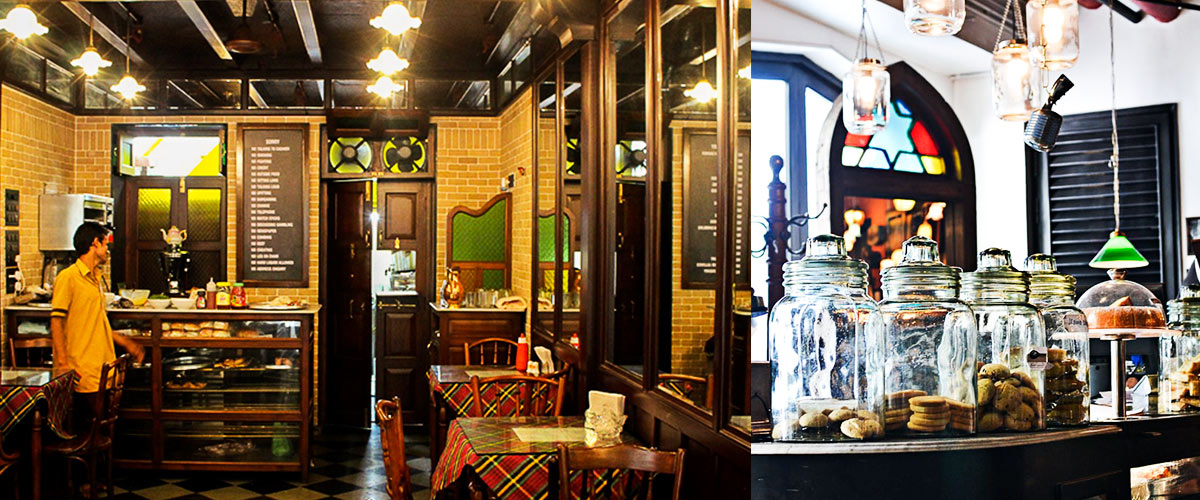At the turn of the 20th century, Bombay was the most modern, the most populated, and the most affluent city in British India. It was – and continues to be – the most cosmopolitan. Among the early settlers were the Parsis, who had fled Iran sometime in the 10th century AD to escape religious persecution. The community is famous for their entrepreneurial spirit and zeal, and are the force behind industries, schools, hospitals and hotels.
This story is about the Irani cafés, a classic Parsi chai house, so called because of their origins. The street corner Irani cafe has, for decades, been part of Bombay’s important landmarks.
My tryst with Irani cafes started when I came to Bombay in the 90s. In crowded south Bombay, every corner had an Irani. The typical cafe had large, well lit dining halls with mirrors strategically placed to reflect light from the outside. Marble tables and beautifully crafted Czech bent-wood chairs filled the cafe.I spent many afternoons here, sipping a cup of chai, with a book in hand.

Sometimes, people watching would take over and I’d enjoy the scenes before me. Of elderly Parsi ladies arguing with their sedate husbands, businessmen from the nearby cloth market striking deals, smitten lovers, broke college kids sharing an omelette… And the lovely thing was that everyone was equally welcome here. The waiters, formally attired in their uniforms, moved easily, pleasantly stopping to check on the customers. Most of us became regulars, stopping to chat with the owner. I remember feeling a sense of being cocooned in a comfort zone here while outside, the crowded noisy city belched fumes.
Most of the Irani cafes also came with a first floor, where one went if one sought privacy. There were little cabins with makeshift curtains and waiters who remembered to discreetly cough before entering. Many of us who grew up in Bombay have the Irani to thank for our first stolen kisses. These little spaces have seen stories of love and heartache. A lucky few remember it for being proposed here. Faroukh Shokriye the owner of Kyaani has been witness to lovers’ tiffs, watching girls storm out, sometimes red eyed, while an unhappy boyfriend would follow, trying to make up.

But of course, it also comes down to the food. Irani cafes are famous for their bun maska chai. Legend has it that the wonderful treacle colour in an Irani chai, comes from boiling milk, tea and sugar with egg shells. While that’s a story that’s never been proved, the Irani chai, served in white tea cups and saucers is a great favorite with Bombayites.
The other favorite off the menu is what’s touted to be the best kheema pao (soft, succulent minced mutton with fresh loaves of bread) in the city. I know of people from strict vegetarian homes who will break all rules when brought face to face with a plate of this delicacy.
And then, there’s that breakfast favorite – the Parsi Akoori or scrambled eggs on toast, another favorite. Breakfast is a time of roaring business at almost all Irani cafes. The in-house bakeries put out batches of freshly baked chicken puffs, mava cup cakes, soft pav, and bread pudding.

There’s a wonderful sense of camaraderie in these cafes, where people of all walks of life come to enjoy a meal. With their moderate pricing, they don’t put off too many people. In a way, these cafes revolutionised public dining.
But, like all good things, the Irani cafe too is dealing with change. Many Irani cafes in Bombay have already downed their shutters with no one to run them. Yet, when the iconic B Merwan on Grant Road was having closure in 2016, the people of Bombay came forward in numbers. Letters were written, newspaper articles were published and requests made to keep it open. The Iranis have become the last bastion of a bygone era.
On a rainy morning last week, I walked inside Kyaani, drenched to the bone, but unable to resist the call of nostalgia. Faroukh waved me in, and ordered a cup of chai for both of us. In a gentle voice, he said it’d keep me from getting a chill. I sat there, among familiar marble tops with bentwood chairs, sipping hot treacle-colored chai from white cups, while the city breathed fumes outside.
And I fervently hope the Irani cafes will live on, for years to come.

